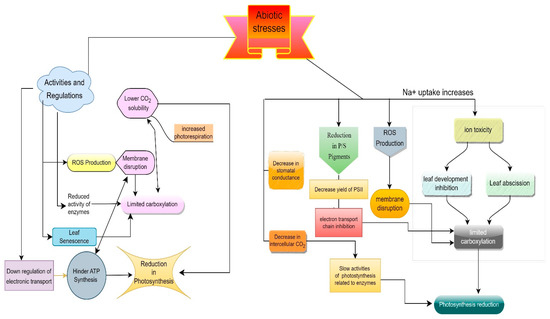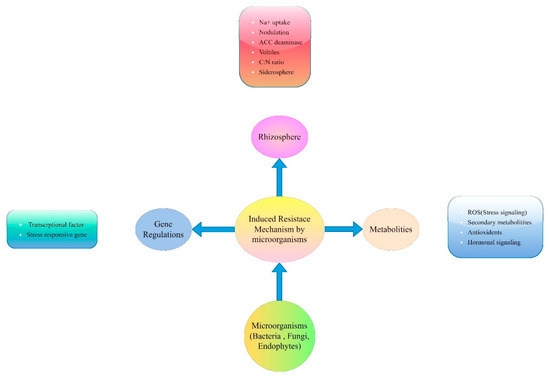You're using an outdated browser. Please upgrade to a modern browser for the best experience.
Please note this is a comparison between Version 1 by Marcelo Carvalho Minhoto Teixeira Filho and Version 2 by Dean Liu.
The challenging alterations in climate in the last decades have had direct and indirect influences on biotic and abiotic stresses that have led to devastating implications on agricultural crop production and food security. Extreme environmental conditions, such as abiotic stresses, offer great opportunities to study the influence of different microorganisms in plant development and agricultural productivity.
- PGPBs
- abiotic stresses
- growth-promoting fungi
1. Introduction
The severe impacts of transmutation with intense episodes of extreme weather can have significant consequences on agricultural outputs that should cause widespread food insecurity and affect survival of populations [1][2][1,2]. The severity, frequency, magnitude, and duration of extreme climatic events will become more highlighted and noticeable in the future [3]. The alterations in climate extremes have a direct or indirect influence on biotic and abiotic stresses with devastating impacts on agricultural crop production and food security [4]. Biotic stresses comprising phytopathogens and pests [5], as well as abiotic stresses including drought [6], soil salinity [6][7][6,7], heavy metals [8][9][8,9], flooding [10], high irradiance [11], low temperature [12] and high temperature [13], can cause intensified impacts on plant growth, physiology, metabolism, nutrient acquisition, and ecological desertification. The diverse effects of abiotic stresses on different mechanisms of plants are summarized in Figure 1.

Figure 1. An overview of the effects of abiotic stresses on the different mechanisms of plants.
In changing climate scenarios, intervention with microbes is considered a new sustainable strategy in agricultural production and mitigation of the resilient impacts of stresses [14]. The beneficial microbes and endophytes exhibit real-time amplifications to alleviate the devastating climatic impacts on plant health, physiology and biochemical aspects [14][15][14,15]. These microbial communities have several adaptations to abiotic stresses under different ecological processes, including facilitation of organic matter decomposition and nutrient acquisition in the rhizosphere of several plants [16]. Beneficial microbes, including plant growth-promoting rhizobacteria (PGPR), may have a controversial influence or no influence at all on plant growth and fitness under stressful environments, whereas other strains of PGPR have beneficial effects under climate-induced stressful extremes [17]. The PGPR engineered for agricultural practices boost plant growth, pathogen control, and microbial ecosystems by alleviating abiotic resiliencies [18][19][18,19].
Plant growth-promoting rhizobacteria tackle abiotic stresses by boosting several physiological and biochemical processes (nutrient uptake, photosynthesis, and source–sink relationships), metabolism and the regulation of homeostasis, osmotic potential, protein function, phytohormone production (indole-3-acetic acid and 1-aminocyclopropane-1-carboxylic acid deaminase), enzymatic activity, and nutrient solubilization [20][21][22][20,21,22]. To combat the punitive impact of abiotic stresses, numerous PGPR strains (including Bradyrhizobium sp. SUTNa-2 [23], Pantoea dispersa IAC-BECa-132, Pseudomonas sp., Enterobacter sp. [24], Bacillus amyloliquefaciens EPP90, Bacillus subtilis, Bacillus pumilus [25], Curtobacterium sp. SAK 1 [26], Burkholderia phytofirmans PsJNT [27], Pseudomonas putida KT2440 [28], Enterobacter sp. [29], Serratia marcescens, Microbacterium arborescens, Enterobacter sp. [30], Bacillus cereus PK6-15, Bacillus subtilis PK5-26 and Bacillus circulans PK3-109 [31], Azospirillum lipoferum FK1 [32], and Azospirillum brasilense Sp7 and Azospirillum brasilense Sp245 [33] have been used to facilitate the management mechanisms of different cereal and legume crops under stressful environments. Plant growth-promoting rhizobacteria employ various strategies to endure harsh weather conditions.
In addition, root-associated microbes such as fungi can potentially influence different ecological processes to optimize plant health and growth, resulting in a great impact on plant physiology, nutrition, and survival ability that improves plant tolerance against environment-induced stresses [34][83]. These endophytic fungi confer abiotic stresses through the synthesis of various plant beneficial substances (ACC-deaminase, auxins, gibberellins, abscisic acid, siderophores) and solubilize nutrients for healthy plant growth [35][36][84,85]. The fugal endophytes form a mutualistic association with plants to promote photosystem activity, protein accumulation, primary metabolism that leads to higher growth, and tolerance under abiotic stresses [37][38][65,86]. Plants develop mutualistic relationships with several plant growth-promoting endophytic fungi, including Piriformospora indica [38][86], arbuscular Mycorrhizal fungi [37][65], Trichoderma albolutescens, Trichoderma asperelloides, Trichoderma orientale, Trichoderma spirale, and Trichoderma tomentosum [39][87], Penicillium aurantiogriseum 581PDA3, Alternaria alternate 581PDA5, Trichoderma harzianum 582PDA7 [40][88], and Porostereum spadiceum AGH786 [41][89], which can increase tolerance against abiotic stresses by improving the biochemical and physiological processes of different plants, as summarized in Figure 2.

Figure 2. Mechanisms against abiotic stresses adapted from microorganisms.
2. Drought Stress
Disruption in the water cycle has become a serious challenge to overcome that is an alarming worry to farmers, horticulturists, and the world’s population as it threatens the food needs of humans and animals. In this context, farmers have increased the amount of irrigation to improve the quantity and quality of agricultural crops; however, this strategy could increase the cost of production [42][90]. Drought can be described as an unfavourable environmental condition with an insufficient level of moisture that can affect normal development and growth cycle of plants [43][91]. It has been highlighted that drought can reduce yield and cultivation potential (ideal yield) of soybean by up to 70% [44][92].
